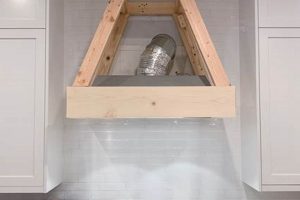A self-constructed, collapsible work surface offers a space-saving solution for individuals requiring a temporary or mobile platform for various tasks. The structure is designed to be easily assembled and disassembled, allowing for convenient storage when not in use. Examples include designs utilizing hinged legs, folding tabletops, or interlocking components, often built from wood or metal.
The significance of such a structure lies in its adaptability and efficient use of limited space. Benefits include increased work area availability in small workshops, portability for on-site projects, and cost-effectiveness compared to purchasing pre-fabricated alternatives. Historically, these types of adaptable work areas have evolved alongside the increasing need for multi-functional spaces, particularly in urban environments and home workshops.
The following sections will elaborate on different design considerations, material choices, and construction techniques applicable to creating this type of adaptable structure. Specific plans, safety precautions, and finishing options will also be addressed, providing a comprehensive guide for successful implementation.
Essential Considerations for a Self-Constructed Collapsible Work Surface
The following are crucial guidelines to ensure the successful design, construction, and utilization of a self-assembled, space-saving work platform.
Tip 1: Material Selection. Prioritize durable materials suitable for the intended workload. Hardwoods, such as maple or oak, provide excellent strength and stability, while metal framing offers superior load-bearing capacity. Consider the weight of the completed structure and the ease of workability of each material.
Tip 2: Joint Integrity. Ensure all joints are securely fastened using appropriate techniques. Mortise and tenon, dovetail, or reinforced screw connections are recommended for wood construction. Welding or bolted connections are appropriate for metal fabrication. Weak joints compromise stability and longevity.
Tip 3: Folding Mechanism Design. Employ robust and reliable folding hardware. Heavy-duty hinges, locking braces, or cam mechanisms are necessary to maintain stability in both the open and closed positions. Investigate commercially available hardware options to streamline construction.
Tip 4: Surface Finish. Apply a durable finish to protect the work surface from damage. Polyurethane, epoxy resin, or specialized workbench coatings offer resistance to scratches, spills, and impact. Proper surface preparation is essential for optimal adhesion and longevity of the finish.
Tip 5: Load Distribution. Design the framework to evenly distribute the weight across the entire structure. Reinforce areas that will bear the brunt of the load. Consider incorporating cross braces or supports to prevent sagging or deformation under heavy use.
Tip 6: Safety Features. Implement safety features to prevent accidental collapse or injury. Locking mechanisms should be easily accessible and secure. Rounded edges and smooth surfaces minimize the risk of cuts or abrasions. Non-slip feet prevent movement during operation.
The adherence to these guidelines will result in a safe, durable, and efficient self-constructed collapsible work surface. By considering material selection, joint integrity, folding mechanism design, surface finish, load distribution, and safety features, the user will maximize the utility and lifespan of the structure.
The subsequent sections will delve into specific design plans and detailed construction procedures, building upon the foundational principles outlined above.
1. Space Optimization
Space optimization is a paramount consideration in the design and implementation of a self-assembled, collapsible work platform. The ability to minimize its footprint when not in use directly correlates to its utility, particularly in environments with limited square footage. The following elements highlight the crucial aspects of space-saving design within this context.
- Folding Mechanism Efficiency
The design of the folding mechanism is central to space optimization. Hinges, brackets, and locking systems must facilitate rapid and compact collapse. An efficient mechanism minimizes the storage volume of the workbench. Consideration must be given to the range of motion of each component to allow for a near-flat or easily storable profile when folded. Examples include designs incorporating pivoting legs or segmented tabletops which fold inward.
- Footprint Reduction Design
Footprint reduction involves minimizing both the deployed and stored dimensions. Careful attention to leg placement, table surface area, and component overlap allows for maximum work surface within a minimal overall size. A compact design ensures that the collapsed structure occupies minimal floor space or can be easily stored against a wall. One example is a workbench featuring legs that fold completely within the perimeter of the tabletop.
- Multi-Functionality Considerations
The adaptability to serve multiple functions can indirectly optimize space. A workbench with integrated storage shelves, tool holders, or a built-in vice can reduce the need for separate, dedicated tools or storage units. By integrating these elements into the design of a collapsible structure, the overall demand for space is reduced. An example is a workbench that doubles as a storage unit when folded, maximizing its utility.
- Vertical Storage Capability
Designing the workbench to facilitate vertical storage further enhances space optimization. This involves ensuring that the collapsed structure can be safely and securely mounted on a wall or stood upright without risk of tipping. Brackets, hooks, or a stable vertical profile are necessary. This approach allows for freeing up floor space, which is particularly advantageous in cramped workshops or garages. An example includes a workbench with integrated mounting points for wall storage.
In conclusion, space optimization is intrinsically linked to the design of a self-assembled, collapsible work platform. An efficient folding mechanism, minimal footprint, multi-functional design, and vertical storage capability all contribute to maximizing usability while minimizing spatial impact. The successful integration of these elements is essential for a practical and space-conscious workshop solution.
2. Structural Integrity
Structural integrity represents a critical design and construction parameter for a self-assembled, collapsible work platform. It directly influences the safe operational load, stability during use, and the overall lifespan of the structure. A compromised structural design can lead to instability, failure under load, and potential user injury.
- Joint Strength and Stabili
tyJoints represent the weakest points in any structure. The selection of appropriate joinery techniques (e.g., mortise and tenon, dovetail, bolted connections) and adhesives is paramount. Weak joints can lead to racking, instability, and eventual collapse under load. The type of joint must be suitable for the materials used and the anticipated stresses. A workbench intended for heavy use necessitates significantly stronger joints than one designed for light-duty tasks.
- Material Selection and Load-Bearing Capacity
The choice of materials directly impacts the workbench’s ability to withstand applied forces. Hardwoods (e.g., maple, oak) and steel offer superior strength compared to softwoods or lightweight composites. The material’s tensile strength, compressive strength, and shear strength must be considered in relation to the anticipated load. The thickness and dimensions of the structural members must be sufficient to prevent bending or buckling under load.
- Bracing and Support Systems
Bracing elements, such as cross-braces or diagonal supports, are crucial for enhancing structural rigidity. These elements resist racking and twisting forces, improving overall stability. The placement and design of bracing systems must be strategically implemented to maximize their effectiveness. Insufficient bracing can result in a wobbly or unstable work surface, compromising both safety and functionality.
- Folding Mechanism Robustness
The folding mechanism itself must be designed to withstand repeated use and applied forces. Hinges, latches, and locking mechanisms must be constructed from durable materials and securely fastened to the structural members. A weak or poorly designed folding mechanism can lead to premature failure, rendering the workbench unusable or potentially hazardous. Regular inspection and maintenance of the folding mechanism are essential for long-term structural integrity.
The factors outlined above collectively contribute to the structural integrity of a self-assembled, collapsible work platform. Proper attention to joint strength, material selection, bracing systems, and the robustness of the folding mechanism is essential for creating a safe, durable, and functional workspace. Ignoring these considerations can lead to compromised performance and potential safety hazards.
3. Portability Factors
Portability factors are intrinsically linked to the functionality and utility of a self-constructed, collapsible work platform. These factors directly influence the ease with which the workbench can be transported and stored, dictating its suitability for mobile applications or use in space-constrained environments. An assessment of weight, folded dimensions, and carrying mechanisms becomes paramount when considering the portability of such a structure.
The weight of the completed workbench is a primary determinant of portability. Lighter materials, such as aluminum or certain composite woods, reduce the overall mass but may compromise structural strength. Conversely, heavier materials, like hardwoods or steel, provide superior load-bearing capacity but increase the difficulty of transport. The optimal balance between weight and strength depends on the intended use case. For example, a workbench intended for on-site construction work requires a higher load-bearing capacity, potentially necessitating a heavier design, while one intended for occasional hobby use might prioritize lightweight portability. Folded dimensions determine the space required for storage and transportation. A compact folded profile allows the workbench to be easily stored in a vehicle, closet, or against a wall. The design of the folding mechanism and the arrangement of components directly influence the folded dimensions. Carrying mechanisms, such as handles, straps, or wheels, facilitate transportation. Strategically placed handles allow for comfortable lifting, while integrated wheels enable easy rolling over various surfaces. The selection of appropriate carrying mechanisms depends on the weight and dimensions of the folded workbench and the typical distances it will be transported. One example can be found in workbenches design to use a hand truck.
Ultimately, the consideration of portability factors is crucial for maximizing the usability of a self-constructed, collapsible work platform. By carefully balancing weight, folded dimensions, and carrying mechanisms, the user can create a workbench that is both functional and easily transportable, adapting to various work environments and storage constraints. Failure to adequately address these factors can result in a cumbersome and impractical structure, limiting its overall utility.
4. Material Cost
The economic feasibility of a self-constructed, collapsible work platform is significantly influenced by the cost of materials. A thorough evaluation of material expenses is essential to determine the overall financial viability of the project and to optimize resource allocation.
- Raw Material Selection and Price Variation
The choice of raw materials (e.g., wood, metal, composites) directly impacts the overall project cost. Hardwoods such as oak or maple offer superior durability but command higher prices compared to softwoods like pine or fir. Steel provides excellent strength but may be more expensive and require specialized tools for fabrication. Composites offer a balance of strength and affordability but may have limitations in terms of structural rigidity. Price fluctuations due to market conditions and supplier availability can further influence material costs. For example, lumber prices may increase due to seasonal demand or supply chain disruptions.
- Hardware and Fastener Expenses
Hardware components, including hinges, latches, screws, bolts, and other fasteners, contribute significantly to the total material cost. High-quality, heavy-duty hardware ensures structural integrity and longevity but comes at a premium. The quantity and type of fasteners required will depend on the complexity of the design and the selected joinery techniques. Sourcing hardware from bulk suppliers or utilizing recycled materials can potentially reduce expenses. The use of specialized hardware, such as locking hinges, will increase the overall cost but can add functionality.
- Finishing and Protective Coating Costs
The application of a protective finish or coating is crucial for extending the lifespan of the workbench and preventing damage from moisture, chemicals, and abrasion. However, the cost of paints, stains, varnishes, or epoxy resins can be substantial. The type of finish selected should be appropriate for the intended use environment and the chosen materials. For example, a workbench exposed to outdoor elements requires a more durable and weather-resistant finish than one used indoors. The cost of application tools, such as brushes, rollers, and sprayers, should also be factored into the overall expense.
- Waste and Material Optimization Strategies
Material waste can significantly increase the overall project cost. Implementing efficient cutting strategies and minimizing scrap material is crucial for cost optimization. Careful planning and accurate measurements can reduce the likelihood of errors and unnecessary waste. Utilizing reclaimed or repurposed materials can further reduce expenses and
promote sustainability. For example, sourcing lumber from demolition sites or using recycled metal can offer significant cost savings.
In summary, material cost represents a significant factor in the feasibility of constructing a self-assembled, collapsible work platform. Careful consideration of raw material selection, hardware expenses, finishing costs, and waste reduction strategies is essential for optimizing resource allocation and achieving a cost-effective outcome. Ignoring these aspects can lead to unexpected expenses and potentially undermine the viability of the project.
5. Ease of Assembly
The constructability of a self-made, space-saving work platform is a crucial determinant of its accessibility to a wide range of users. The simplicity of the assembly process directly impacts project completion rates, user satisfaction, and the potential for widespread adoption of such designs. Ease of assembly necessitates careful consideration of design complexity, component count, and the skill level required for successful execution.
- Simplified Design and Component Reduction
A design characterized by fewer parts and straightforward construction techniques directly enhances ease of assembly. Complex joinery, intricate cuts, and elaborate mechanisms increase the difficulty of the project. Reducing the number of unique components streamlines the assembly process and minimizes the potential for errors. An example is a design utilizing pre-cut lumber and minimal hardware, requiring only basic tools and skills. Conversely, a design incorporating complex miter joints and custom-fabricated metal components would significantly increase the assembly difficulty.
- Clear and Concise Instructions
Comprehensive and easily understandable instructions are essential for guiding users through the assembly process. Instructions should include detailed diagrams, step-by-step procedures, and clear labeling of all components. Ambiguous instructions or missing information can lead to frustration, errors, and project abandonment. Well-written instructions anticipate potential challenges and provide solutions for common problems. An example is instructions incorporating 3D renderings and video tutorials to supplement written guidance. Conversely, vague or incomplete instructions can render even a simple design difficult to assemble.
- Tool Requirements and Skill Level
The tools required for assembly and the necessary skill level directly impact the accessibility of the project. A design requiring specialized tools or advanced woodworking skills will limit its appeal to experienced craftspeople. A project utilizing readily available tools, such as a drill, screwdriver, and saw, is more accessible to a wider audience. The skill level required should be clearly indicated in the project description. An example is a design specifically tailored for beginner woodworkers, requiring only basic skills and tools. Conversely, a design demanding advanced welding techniques or complex joinery is unsuitable for novice builders.
- Modular Design and Pre-Assembly
Employing a modular design, where components are pre-assembled into sub-units, greatly simplifies the overall assembly process. This approach reduces the number of individual steps and minimizes the potential for errors. For example, pre-assembling the folding legs or the tabletop frame as separate modules simplifies the final assembly stage. The modular design can be especially beneficial for projects with complex geometry or repetitive tasks. Pre-assembly, performed by the designer or a third-party, further reduces the burden on the end-user.
The preceding facets demonstrate the crucial link between ease of assembly and the viability of a self-made, collapsible work platform. By prioritizing simplified designs, clear instructions, minimal tool requirements, and modular construction, such a workbench becomes accessible to a wider range of individuals, promoting its widespread adoption and utility.
6. Weight Capacity
Weight capacity represents a pivotal design parameter for any self-constructed, collapsible work platform. It dictates the range of tasks the workbench can accommodate safely and reliably, directly influencing its functionality and utility. The determination of adequate weight capacity involves a thorough assessment of anticipated loads and a robust structural design.
- Material Strength and Structural Design
The selection of appropriate materials and a sound structural design are fundamental to achieving the desired weight capacity. Hardwoods, such as maple or oak, and metals, like steel, offer superior load-bearing capabilities compared to softwoods or lightweight composites. The structural design, including the dimensions of the frame members and the type of joinery employed, must be meticulously engineered to withstand the anticipated forces. For example, a workbench intended for supporting heavy machinery or large workpieces necessitates a more robust frame and stronger materials than one designed for light-duty tasks. Deficient material selection or inadequate structural design will compromise the weight capacity and pose a safety risk.
- Load Distribution and Support Systems
The manner in which the load is distributed across the work surface and the presence of effective support systems significantly influence the overall weight capacity. Concentrated loads can create stress points that exceed the material’s yield strength, leading to deformation or failure. Evenly distributing the load through the use of a solid tabletop or strategically placed supports minimizes stress concentrations. Cross-bracing, gussets, and additional legs can provide supplemental support, increasing the workbench’s ability to handle heavier loads. A workbench with inadequate load distribution or insufficient support will exhibit reduced weight capacity and potential instability under load.
- Joint Integrity and Fastener Strength
The integrity of the joints and the strength of the fasteners are critical components of the workbench’s weight capacity. Weak or poorly executed joints can fail under stress, compromising the entire structure. The selection of appropriate joinery techniques (e.g., mortise and tenon, dovetail, bolted connections) and the use of high-quality fasteners (e.g., screws, bolts, adhesives) are essential. The quantity and placement of fasteners must be carefully considered to ensure adequate holding power. A workbench with compromised joint integrity or insufficient fastener strength will exhibit reduced weight capacity and be prone to failure under load.
- Folding Mechanism and Stability
The design and construction of the folding mechanism directly influence the stability and weight capacity of the workbench in its deployed configuration. The mechanism must securely lock the legs and tabletop in place, preventing movement or collapse under load. The materials used in the folding mechanism must be durable and capable of withstanding repeated stress. The mechanism’s geometry should provide a stable base of support. A poorly designed or constructed folding mechanism can compromise the weight capacity and create a significant safety hazard.
The multifaceted nature of weight capacity underscores its importance in the design and construction o
f a self-assembled, collapsible work platform. By carefully considering material strength, structural design, load distribution, joint integrity, and the stability of the folding mechanism, the user can create a workbench that safely and reliably accommodates the intended tasks, ensuring both functionality and user safety. Ignoring these considerations can result in a compromised structure with limited utility and increased risk of failure.
7. Safety Features
The incorporation of safety features into the design and construction of a self-assembled, collapsible work platform is not merely an optional consideration, but an imperative for ensuring user well-being and preventing potential accidents. The inherent mobility and collapsibility of these structures necessitate a proactive approach to safety to mitigate risks associated with instability, accidental collapse, and sharp edges.
- Locking Mechanisms for Stability
Robust locking mechanisms are essential to prevent unintended collapse during use. Hinges, latches, and braces must securely engage to maintain the structural integrity of the deployed workbench. Examples include spring-loaded pins, over-center latches, and threaded fasteners. Failure of locking mechanisms can lead to sudden instability, potentially causing injury to the user or damage to the workpiece. The selection of high-quality, durable locking hardware and regular inspection for wear or damage are crucial.
- Edge Protection and Smooth Surfaces
The mitigation of sharp edges and rough surfaces minimizes the risk of cuts and abrasions. All exposed edges should be rounded or chamfered to eliminate potential hazards. Surfaces should be sanded smooth and finished with a durable coating to prevent splinters. Examples include the use of edge banding, radius cutters, and fine-grit sandpaper. Ignoring edge protection can lead to minor injuries that, while seemingly insignificant, can disrupt workflow and potentially lead to infection.
- Weight Distribution and Load Capacity
Understanding and adhering to the designed weight capacity is paramount. Overloading the workbench can compromise its structural integrity, leading to instability or collapse. Clearly marked weight limits and a design that distributes load evenly are essential safety features. Examples include reinforced support structures, strategically placed legs, and a solid tabletop. Exceeding the weight capacity can result in catastrophic failure, posing a significant risk of injury and equipment damage.
- Non-Slip Feet and Grounding
The prevention of unwanted movement during use is achieved through the incorporation of non-slip feet. These feet provide traction on various surfaces, minimizing the risk of the workbench sliding or shifting. In environments where electrical tools are used, grounding the metal frame can prevent electrical shock. Examples include rubber feet, adjustable leveling feet, and grounding wires connected to a suitable earth ground. Failure to provide adequate traction can lead to instability, while neglecting grounding can create a serious electrical hazard.
In conclusion, the integration of safety features into a self-assembled, collapsible work platform directly impacts user safety and the longevity of the structure. From robust locking mechanisms and edge protection to weight distribution considerations and non-slip feet, a comprehensive approach to safety is essential for creating a functional and reliable workspace. Overlooking these features can have significant consequences, underscoring the importance of prioritizing safety in the design and construction process.
Frequently Asked Questions
This section addresses common inquiries and misconceptions regarding self-constructed, collapsible work platforms, providing concise and informative answers to assist in design, construction, and usage.
Question 1: What is the minimum required skill level for constructing a DIY foldable workbench?
The required skill level varies depending on the complexity of the chosen design. A basic foldable workbench can be constructed with fundamental woodworking skills, including measuring, cutting, and fastening. More complex designs incorporating intricate joinery or metal fabrication techniques necessitate advanced skills.
Question 2: What are the most suitable materials for a durable DIY foldable workbench?
Hardwoods, such as maple or oak, provide excellent durability and load-bearing capacity for the tabletop and frame. Steel framing offers superior strength but requires welding skills. Plywood can be used for the tabletop, but should be adequately supported to prevent sagging. The selection of materials depends on the intended use and budget.
Question 3: What are the key considerations for ensuring the stability of a foldable workbench?
Stability is achieved through robust joinery, adequate bracing, and a well-designed folding mechanism. Joints should be securely fastened using appropriate techniques, such as mortise and tenon or bolted connections. Cross-bracing prevents racking and twisting. The folding mechanism must lock securely in both the open and closed positions.
Question 4: How can the weight of a DIY foldable workbench be minimized without compromising structural integrity?
Weight can be minimized by utilizing lightweight materials, such as aluminum or thin-gauge steel, for the frame. Hollow-core doors or lightweight plywood can be used for the tabletop, provided they are adequately supported. Careful design optimization can reduce the overall material usage without sacrificing strength.
Question 5: What are the essential safety precautions to observe when constructing and using a DIY foldable workbench?
Safety precautions include wearing appropriate personal protective equipment (e.g., safety glasses, gloves), using tools safely, and ensuring that the workbench is stable and properly locked before use. Overloading the workbench should be avoided. Electrical tools should be properly grounded.
Question 6: How can a DIY foldable workbench be effectively stored when not in use?
Effective storage depends on the design and available space. The workbench can be designed to fold flat and lean against a wall. Alternatively, it can be hung on wall-mounted brackets or stored in a closet. The folding mechanism should be designed for ease of operation and secure locking in the folded position.
These FAQs provide a starting point for understanding key aspects of self-constructed, collapsible work platforms. Careful planning and adherence to safety guidelines are essential for a successful project.
The following section will provide detailed instructions for building a specific DIY foldable workbench design, incorporating the principles outlined in this article.
Concluding Remarks on DIY Foldable Workbench Construction
This exploration has provided a comprehensive overview of factors critical to the design, construction, and utilization of a diy foldable workbench. From material selection and structural integrity to portability, cost considerations, ease of assembly, weight capacity, and crucial safety features, each element contributes to the overall functionality and utility of such a structure. A thorough understanding of these aspects is paramount for any individual undertaking the construction of a self-assembled, space-saving work platform.
The success of a diy foldable workbench pr
oject hinges on meticulous planning and diligent execution. By carefully considering the principles outlined herein, individuals can create a valuable asset for their workspace, adapting to spatial constraints and project demands. The ongoing refinement of designs and techniques ensures the continued relevance and utility of this adaptable workspace solution, promoting both efficiency and safety in a variety of environments. Further research and experimentation are encouraged to optimize the performance and durability of these self-constructed work platforms.







